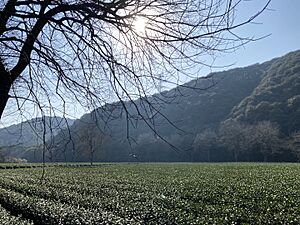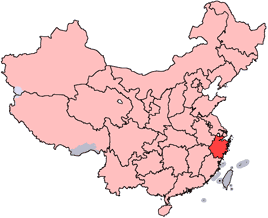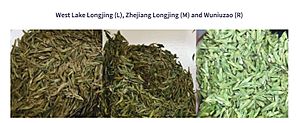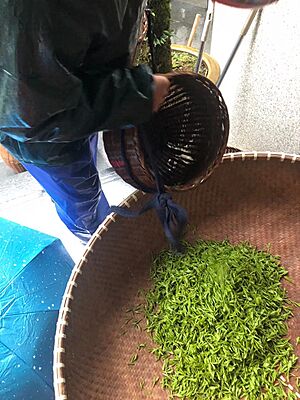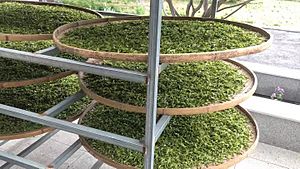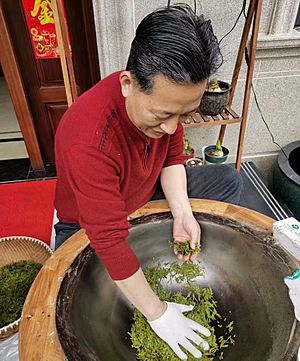Longjing tea facts for kids
| File:Longjing tea.jpg | |
| Type: | Green tea |
|
|
|
| Other names: | Dragon Well tea |
| Origin: | Hangzhou, Zhejiang Province, China |
|
|
|
| Quick description: | Very gentle and sweet |
|
|
|
Longjing tea (which means Dragon Well tea) is a special kind of green tea. It comes from a place called Longjing Village in Hangzhou, Zhejiang Province, China. People make this tea mostly by hand. It is famous for being very high quality. Because it's so good, it has been named a "China Famous Tea."
Contents
What's in Longjing Tea?
Longjing tea has good things like vitamin C and special building blocks called amino acids. Like many good Chinese green teas, it also has high amounts of healthy plant compounds called catechins. These are good for your body!
How Longjing Tea Grows Best
Growing Conditions for Longjing Tea
Longjing tea plants need just the right conditions to grow well. This includes enough water, the right temperature, and the right amount of sunlight.
Water Needs
Tea plants need a lot of water to grow, especially when new shoots are forming. Longjing tea trees need more water than many other plants. They grow best when there is plenty of rain throughout the year. The air also needs to be quite humid.
Temperature for Tea Plants
The best temperature for Longjing tea plants is between 10°C and 20°C (about 50°F to 68°F). If it gets too hot, above 35°C (95°F), the tea plants won't grow as well.
Sunlight and Shade
Longjing tea plants like sunlight but also need some shade. Too much direct sun can be bad for them. Most of the plant's growth comes from photosynthesis, which uses sunlight. Leaves that get the right amount of light are stronger and have a better color. They also have more of the good things that make the tea taste great.
Why Hangzhou is Perfect for Longjing Tea
Experts have found that the area around Hangzhou is perfect for growing Longjing tea. The temperature, light, humidity, and rainfall are just right. The southwest part of the West Lake area in Hangzhou is especially good.
Hangzhou has a mild, often rainy climate. This creates the perfect conditions for the tea to develop its best flavor. The best time to pick West Lake Longjing tea is from late March to April. During this time, the temperature is usually between 10°C and 20°C. This helps the tea buds stay small and high quality.
The area around West Lake and the Qiantang River has high air humidity and less direct sunlight. These are ideal conditions for Longjing tea. Because of this climate, West Lake Longjing tea has many amino acids, which give it a fresh taste. It also has fewer tea polyphenols, which can make tea taste bitter. This combination makes it very nutritious and delicious.
Longjing Tea Quality
Longjing tea is a popular tea that many people drink every day. It can be quite affordable, but the very best kinds can be expensive. There are many different types of Longjing tea.
Longjing tea is sorted into six grades: "Superior" and then grades 1 through 5. You can often tell the quality by looking at the tea leaves after they have been steeped in hot water. High-quality Longjing teas have tender, whole leaves that look the same. Lower quality teas might have leaves that vary in color. Before you steep it, good quality Longjing tea leaves are flat and light green.
Studies have shown that a darker green color in Longjing tea might mean lower quality. The best-tasting teas have more free amino acids and theanine, which make the flavor good.
Legends of Dragon Well Tea
Longjing tea was so special that a famous emperor, the Kangxi Emperor, made it "imperial tea" during the Qing dynasty.
His grandson, the Qianlong Emperor, also loved Longjing tea. One story says he visited a temple near Lion Peak Mountain. He was given a cup of Longjing tea and was so impressed! In front of the temple were 18 tea bushes. The emperor gave these 18 bushes a special imperial status. These tea trees are still alive today. The tea they produce is sold for a very high price, even more than gold!
Another legend says that while the Qianlong Emperor was watching ladies pick tea, he decided to try it himself. While he was picking, he got news that his mother was sick. He quickly put the leaves he had picked into his sleeve and rushed back to Beijing. When he saw his mother, she noticed the smell of the tea leaves. He immediately brewed them for her. It is said that the flat shape of Longjing tea was inspired by these leaves that the emperor brewed for his mother.
The name "Longjing" means "dragon well." It's named after a well that has very dense water. After it rains, the lighter rainwater floats on top of the well water. This creates a wavy line that looks like a Chinese dragon moving!
People also say that to get the best taste from Longjing tea, you should use water from the Dreaming of the Tiger Spring. This is a famous spring in Hangzhou. The tea gets its name from the "Dragon Well" near Longjing village.
Real Longjing Tea
What makes Longjing tea "authentic" can be tricky. Most people agree that real Longjing tea must come from the Zhejiang province in China. The strictest definition says it must come from the villages and farms in the West Lake area of Hangzhou.
However, a lot of Longjing tea sold today does not actually come from Hangzhou. Many "fake" Longjing teas are made in other provinces like Yunnan or Sichuan. Some sellers will tell you if their tea is not from Zhejiang. Some tea makers use fresh leaves from other provinces and process them using Longjing methods. Others might mix a small amount of high-quality tea with lower-quality tea and sell it as expensive, high-grade tea.
Authentic Longjing tea tastes sweet and smooth. Some types taste a bit like vegetables or grass. Others might have a hint of roasted chestnut or butter.
There are also many different types of Longjing tea plants, called cultivars. The "Old Tree" (Qunti) and "No.43" types are the most famous and expensive. They have strong smells and tastes. "Wuniuzao," also called "Early Longjing," is picked very early in the season and has a lighter taste.
It can be hard, even for experts, to tell all the different types and where they come from. This is why many cheap fake teas can trick people. But you can often spot differences by comparing the look, smell, and color of the brewed tea.
How Longjing Tea is Made
Like most other Chinese green teas, Longjing tea leaves are heated very early in the process, right after they are picked. This stops them from oxidizing. Oxidation is a natural process that happens when leaves are exposed to air, and it's what makes black and oolong teas. For green tea, this heating (often called "firing" or "roasting" in pans) keeps the leaves green. Longjing tea leaves are oxidized very little. When you steep them, the tea turns a yellow-green color.
Picking Times
West Lake Longjing tea is picked in a special way: early, tender, and diligently.
Pre-Qingming Longjing
The best and most expensive Longjing tea is called Ming Qian or Pre-Qingming tea. This tea is made from the very first spring shoots picked before the Qingming Festival, which is around April 5th each year. After the festival, it often rains, and the temperature gets warmer. This makes the tea plants grow faster. When the tea bud gets too big, it loses some of its complex flavor. That's why pre-Qingming tea is considered the best.
Guyu (Grain Rain)
Tea picked before the "Grain Rain" period in mid-April is also very good. This is called Yuqian Tea.
Drying After Picking
After picking, Longjing tea leaves need to dry for about half a day on bamboo screens. They are spread out thinly. This step helps to reduce any grassy taste in the leaves. It also prepares them for frying, makes the tea smell better, and reduces bitterness. It helps the tea stay fresh and prevents the leaves from clumping together when they are fried.
Frying the Tea
Frying the tea is a very important step. It's also called "Green pot." This is where the leaves are heated to remove water and start shaping them. When the pan is hot (80-100°C), about 100 grams of dried leaves are put in. The tea maker uses their hands to fry the leaves.
They start by gently grasping and shaking the leaves. As the leaves lose water, the tea maker changes their technique. They start pressing, shaking, and throwing the leaves to shape them. The pressure changes from light to heavy. This helps to straighten the leaves and flatten them. When the tea leaves are about 70% to 80% dry, the frying stops. This whole process takes about 12-15 minutes.
Longjing Tea Areas
Within the Xihu (West Lake) area, there are five main peaks where Longjing tea is grown. They are ranked by how desirable their tea is: Lion, Dragon, Cloud, Tiger, and Plum Flower.
- Shi Feng Longjing: This type comes from the Shi Feng (Lion Peak) area. It tastes fresh and has a strong, lasting smell. Its leaves are yellowish-green. Some dishonest tea makers might over-fry their tea to try and copy this color.
- Cloud Peak is a government testing area. The tea from here is usually not sold to the public.
- Tiger Spring Longjing: This tea is named after the best water source in the Tiyun Mountains. This type of Xihu Longjing tastes wonderful even after you steep it many times.
- Meijiawu Longjing: This tea comes from the area around Meijiawu village. It is known for its beautiful jade green color.
- Bai Longjing: This is not a true Longjing tea, but it looks like one. It's actually a type of green tea from Anji County in the Zhejiang Province. It was created in the 1980s. It comes from a type of White tea tree, which is very unusual. It is said to have more amino acids than regular Green tea.
- Qiantang Longjing: This tea comes from just outside the Xihu district. It is usually not as expensive as Xihu Longjing.
Protecting Longjing Tea
Longjing tea (龙井茶 / Longjing cha) is protected in the European Union and the UK. This means that only tea made in specific areas of China can be called "Longjing tea" there. This is similar to how certain wines or cheeses are protected, ensuring their quality and origin.


